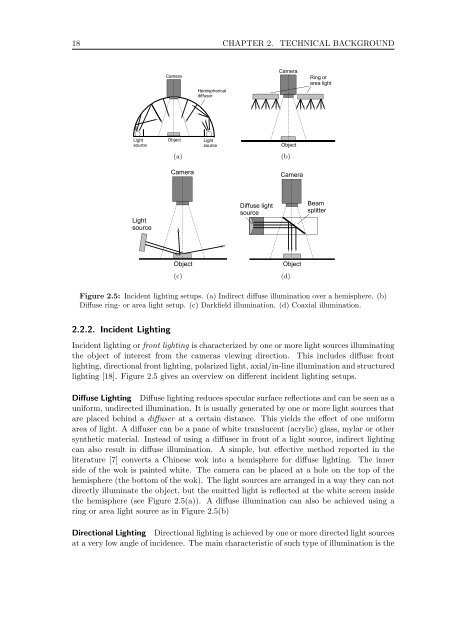Master Thesis - Fachbereich Informatik
Master Thesis - Fachbereich Informatik
Master Thesis - Fachbereich Informatik
Create successful ePaper yourself
Turn your PDF publications into a flip-book with our unique Google optimized e-Paper software.
18 CHAPTER 2. TECHNICAL BACKGROUND<br />
(a) (b)<br />
(c) (d)<br />
Figure 2.5: Incident lighting setups. (a) Indirect diffuse illumination over a hemisphere. (b)<br />
Diffuse ring- or area light setup. (c) Darkfield illumination. (d) Coaxial illumination.<br />
2.2.2. Incident Lighting<br />
Incident lighting or front lighting is characterized by one or more light sources illuminating<br />
the object of interest from the cameras viewing direction. This includes diffuse front<br />
lighting, directional front lighting, polarized light, axial/in-line illumination and structured<br />
lighting [18]. Figure 2.5 gives an overview on different incident lighting setups.<br />
Diffuse Lighting Diffuse lighting reduces specular surface reflections and can be seen as a<br />
uniform, undirected illumination. It is usually generated by one or more light sources that<br />
are placed behind a diffuser at a certain distance. This yields the effect of one uniform<br />
area of light. A diffuser can be a pane of white translucent (acrylic) glass, mylar or other<br />
synthetic material. Instead of using a diffuser in front of a light source, indirect lighting<br />
can also result in diffuse illumination. A simple, but effective method reported in the<br />
literature [7] converts a Chinese wok into a hemisphere for diffuse lighting. The inner<br />
side of the wok is painted white. The camera can be placed at a hole on the top of the<br />
hemisphere (the bottom of the wok). The light sources are arranged in a way they can not<br />
directly illuminate the object, but the emitted light is reflected at the white screen inside<br />
the hemisphere (see Figure 2.5(a)). A diffuse illumination can also be achieved using a<br />
ring or area light source as in Figure 2.5(b)<br />
Directional Lighting Directional lighting is achieved by one or more directed light sources<br />
at a very low angle of incidence. The main characteristic of such type of illumination is the














